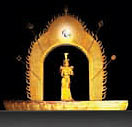| My Dream 我的梦想(组图) |
| http://www.sina.com.cn 2004/12/13 19:01 中国周刊 |
Former Chinese President Jiang Zemin pointed out that “one-tenth of the world's population are handicapped, but they deserve their dignity, rights and value as human beings. They have the aspiration and capabilities to participate in social life, and are the creators of material and spiritual wealth of mankind as well." Speaking highly of the troupe's artistic creations, he said it "displays the stalwart will of the Chinese people in their constant struggle, and reflects the staunch perseverance of handicapped people throughout the world in creating their own lives.” “The troupe's artistic contributions are a new bud in mankind's artistic floral garden and a vivid symbol of the cordial love and pursuit of art by handicapped people,” said Jiang. At the 1998 Goodwill Games, a promising gymnast, a vaulting queen, Sang Lan, was injured in a competition fall and became paraplegic. Inspired, she joined the group as a poet, using sign language to deliver her message. It was with a joyful heart that I entered the venue for the performance of My Dream. What followed took my breath away, over and over again. There was a hush in the crowd as the curtain drew for a rousing song by suit-clad blind men. A female soprano seated in gowned elegance in her wheelchair performed a clear, poignant, and emotional aria-like ethnic piece.
Not only was the staging spectacular, with creative lighting and gorgeous costumes, but the flow from one act onto another was precision-timed. I was mesmerised by a dozen beautiful, willowy, deaf-mute women whose intricate choreography wove through an act entitled Thousand-hand Bodhisattva. Dressed in shimmering yellow-gold, depicting Buddha, their flowing arms and hands, tipped with exaggerated, long, gold-lacquered fingernails, played out a cultural story of people and nature in harmony. In a joyous rendition of the globally popular Irish Riverdance, blind tappers recreated a number they’d never been able to see, let alone copy, with such precise movements that no mistakes could be detected. Another blind girl performed a sinuous, sensuous solo which embodied the graceful Peacock. She left me gasping. For me, the most outstanding performance came from an ensemble of five young men, each of whom had lost his entire right leg. Having exercised their bodies to the peak of balance and strength, they did not need to use their crutches for their intended purpose, as such. Instead, during their Wings of Life routine, their supports went virtually unnoticed for what they were, but were effectively used as dance props. Their gymnastic stretch suits only emphasised the irony of their exquisite physical form and muscular prowess. I applauded loudly after their moments of pure magic. The show closed with the introduction of a full orchestra off-stage. In keeping with the rest of the cast, the conductor was mentally handicapped, a Down's Syndrome child. Born into a musical family, he possessed a profound sense of rhythm which developed further in his daily exposure to classical recordings. Unable to read music or play an instrument, he nonetheless took the baton in hand, and smiling from ear to ear, directed the musicians in a resounding version of the famous William Tell overture. It was magnificent. The show has been described in its publicity materials as one that 'projects the dignity of mankind, the value of life... the fortitude of will'. It does. Don’t miss it – and take some tissue. |
|
|
|
|
|
| Annotation |
| 新闻查询帮助 | |
| 热 点 专 题 | ||||
| ||||
|
教育频道意见反馈留言板 电话:010-62630930-5178 欢迎批评指正
新浪简介 | About Sina | 广告服务 | 联系我们 | 招聘信息 | 网站律师 | SINA English | 会员注册 | 产品答疑
Copyright © 1996 - 2004 SINA Inc. All Rights Reserved
版权所有 新浪网![]() 北京市通信公司提供网络带宽
北京市通信公司提供网络带宽

